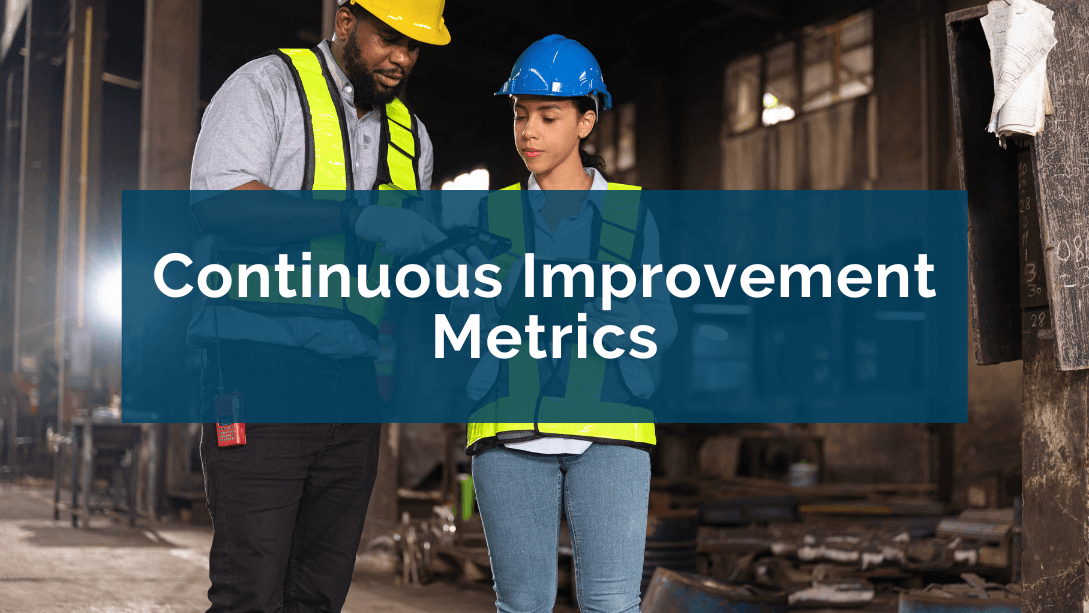What are continuous improvement indicators?
A continuous improvement indicator is a quantitative or qualitative measure that enables us to continuously assess progress in implementing Lean principles. These indicators provide crucial information for identifying areas for improvement, evaluating the results of Lean initiatives, and fostering a culture of continuous improvement.
8 Continuous improvement metrics to measure your company's progress
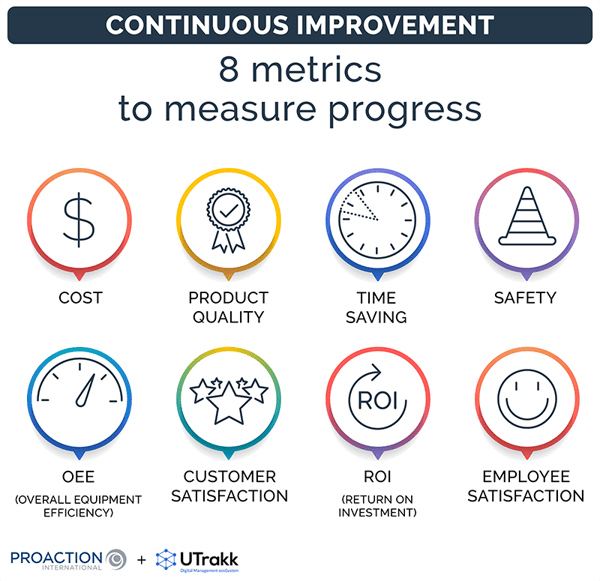
1. Safety
Taking employee safety into account is a top priority. Safety indicators measure workplace incidents and safe practices.
Examples of safety indicators:
- Frequency rate (FR)
- Severity rate (SR)
- Frequency index (FI)
2. Cost
Reducing costs while maintaining quality is a fundamental objective of Lean. Cost indicators monitor direct and indirect expenses, including production (transformation of raw material into product), labor, and logistics costs.
Examples of cost indicators:
- Production cost per unit
- Labor cost per product
- Overall logistics cost
3. Product quality
Quality indicators focus on defects, rejects, and non-conformities. Improved manufacturing quality translates into more reliable products and services that better meet customer needs.
Examples of product quality indicators:
- First-pass yield rate
- Rejection rate
- Scrap rate
4. Overall Equipment Efficiency (OEE)
OEE measures the efficiency of production equipment by considering downtime, production rates, and quality. A high OEE indicates optimum use of resources.
The formula for calculating OEE is:
OEE = Availability x Performance x Quality
Examples of OEE indicators:
- Equipment availability (machine utilization rate)
- Equipment performance (machine efficiency rate)
- Equipment quality (rate of compliant products)
5. Time savings
Reducing cycle times and minimizing waiting times are key Lean objectives. Time-saving indicators measure delays, idle times, and lead times. Reducing these times helps to improve the company's responsiveness.
Examples of time-saving indicators:
- Production cycle time
- Inventory turnover time
- Machine downtime
6. Customer satisfaction
Customer surveys, customer loyalty indicators, customer feedback, and customer complaints are essential to check that the company is effectively meeting its customers' needs and providing them with genuine added value.
Examples of customer satisfaction indicators:
- Customer satisfaction rate
- Net Promoter Score (NPS)
- Customer effort rate
7. Return on investment (ROI)
ROI measures the benefits obtained compared to project investments. It is essential to ensure that benefits exceed costs.
Examples of ROI indicators:
- Customer acquisition cost
- Customer lifetime value
- Return on assets
8. Employee satisfaction
Satisfied employees are more likely to participate actively in the continuous improvement process and to stay with the company. Engagement surveys, staff turnover rates, and employee satisfaction indicators help assess the positive impact of Lean and continuous improvement efforts on well-being from a team's point of view.
Examples of employee satisfaction indicators:
- Employee turnover rate
- Employee engagement rate
- Employee Net Promoter Score (eNPS)
By tracking these indicators, companies can assess their performance and determine the corrective actions needed to develop their Lean approach.
Why should you measure continuous improvement?
Measuring continuous improvement isn't just a wise choice for companies looking to follow Lean; it's necessary. We explain why.
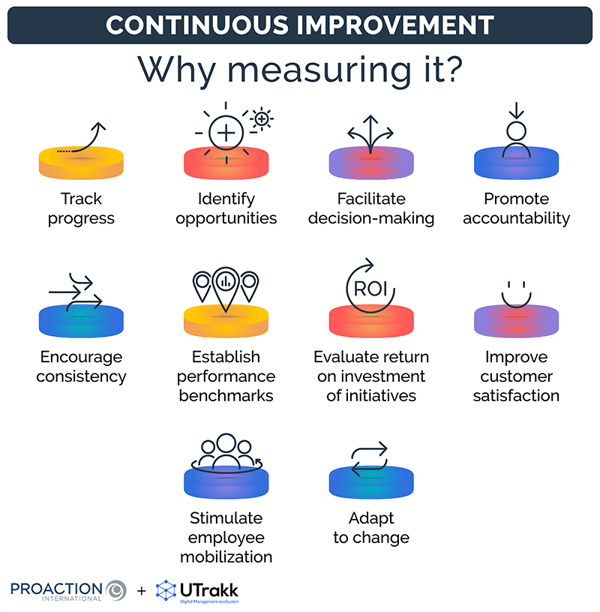
Track progress
Measuring continuous improvement makes it possible to track improvement projects’ progress towards set objectives and gives a clear vision of the company's evolution.
Such measurements are necessary to quantify changes and determine whether efforts are effective.
Identify opportunities
Measuring continuous improvement enables you to identify opportunities for process optimization, cost reduction, quality enhancement, and customer satisfaction.
Facilitate decision-making
The data collected through indicators provides a solid basis for making informed choices. Managers can weigh the advantages and disadvantages of different strategies and then determine the best course of action.
Promote accountability
When targets are set, teams are encouraged to take responsibility for achieving them. Data transparency also encourages employees to be accountable and to work towards common improvement goals.
Encourage consistency
Consistency in quality, operations, and results is a key element of Lean. By measuring continuous improvement, companies can ensure that quality standards are met (ISO 9001, for instance), processes are consistent, and results are consistent.
Establish performance benchmarks
Comparisons with other organizations, known as benchmarking, are facilitated by continuous improvement indicators. These enable the company's performance to be measured against others in the same sector, identifying areas where improvement is needed to remain competitive.
Evaluate the return on investment of initiatives
Lean often involves significant investments in time, money, and resources. Measuring continuous improvement enables us to assess whether these investments have generated a positive return, redirect resources toward the most profitable initiatives, and optimize capital use.
Improve customer satisfaction
By measuring continuous improvement, companies can identify the areas in which they need to improve to better respond to customer needs and thus better satisfy them (quality, speed, reliability of products/services).
Stimulate employee engagement
Engaged employees are more productive and actively contribute to continuous improvement. Companies boost staff involvement and motivation by showing them the results of Lean initiatives and including them in improvement methods.
Adapt to change
Measuring continuous improvement helps companies adapt by quickly identifying emerging challenges and adjusting strategies to meet them. It enables them to remain agile and competitive in an ever-changing world.
8 Steps to measure continuous improvement
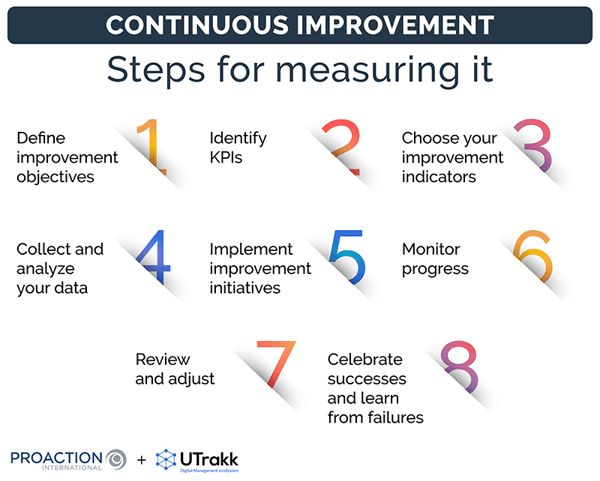
1. Define improvement objectives
Objectives must be clear and specific, aligned with the company's strategic vision, and linked to areas where improvements are needed.
For example, a manufacturer might aim to reduce cycle times by 20% over the next six months.
2. Identify key performance indicators
Once you've established your parameters, identify the key performance indicators (KPIs) that will enable you to measure progress toward these objectives.
To reduce cycle times, KPIs include average order processing time, waiting time, and delivery time.
3. Choose your improvement indicators
Choose improvement indicators according to their relevance to your objectives. Avoid having too many, as this can complicate management. Concentrating on a few KPIs linked to the main objective is generally advisable.
4. Collect and analyze your data
Collecting data is essential for assessing current performance and measuring progress. Data can come from various sources (surveys, field inspections, IT systems, etc.), but must be accurate and reliable.
Data analysis involves comparing results with targets and identifying trends, variations, and underlying causes.
5. Implement improvement initiatives
Based on the information gathered during data analysis, you need to implement improvement initiatives. These may include process adjustments, staff training, investment in new technologies, or organizational changes.
Each initiative must be aligned with objectives and KPIs.
6. Monitor progress
Monitoring ongoing progress ensures that improvement initiatives produce the desired results. It means regularly monitoring KPIs to see whether targets are being met, exceeded, or missed.
If progress is not aligned with expectations, corrective action must be taken promptly.
7. Review and adjust
A periodic review of performance, objectives, and initiatives is necessary to adjust the continuous improvement program. This step identifies what's working well and what isn't so that appropriate adjustments can be made.
It may also involve questioning specific ways of doing things and revising objectives if changes occur in the company's environment.
8. Celebrate successes and learn from failures
It's important to celebrate successes and recognize team achievements to motivate employees and reinforce their commitment to continuous improvement.
Similarly, failures should not be ignored but rather seen as learning opportunities, as the lessons learned from them can open the door to future improvement initiatives.
Dashboards and visual management for better tracking of continuous improvement indicators
Dashboards
Dashboards provide a visual representation of a company's key performance indicators. They provide a comprehensive view of progress concerning objectives and help to make informed decisions.
In the context of continuous improvement, they enable KPIs to be brought together in one place, data to be tracked in real-time, and trends to be analyzed over time.
On the UTrakk daily management platform, the Dashboard module enables performance indicators to be determined and data to be recorded at predefined frequencies. The results, displayed in graphical form, make it easy to monitor progress and take corrective action if necessary.
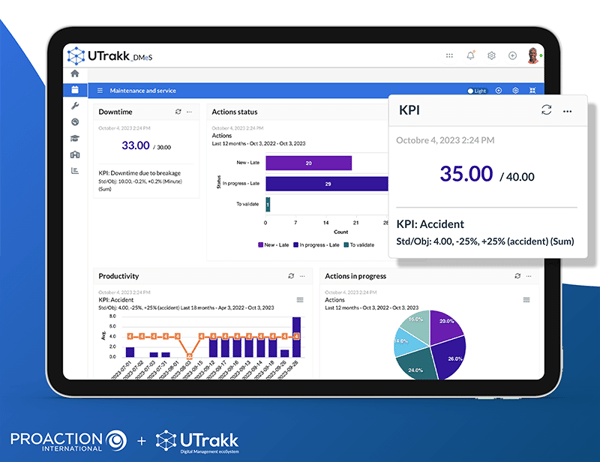
Visual management
This involves using visual elements such as tables, displays, colored indicators, and diagrams to represent information clearly and intuitively.
In the context of continuous improvement, it enables critical indicators and information to be clearly communicated, priorities to be highlighted, problems to be identified, and team progress to be highlighted.
Measuring and managing continuous improvement for ongoing success
Measuring and managing continuous improvement is not simply a way to assess past prowess, but rather gas pedals ultimately leading toward future operational performance.
Manufacturing companies that embrace this approach set themselves on the path to operational excellence and ongoing success. Measuring and monitoring key indicators and adjusting actions based on results create an environment conducive to growth, productivity, and customer and employee satisfaction.
Continuous improvement thus becomes a culture, a mentality, and a strategy for the company. It's a commitment to constant innovation, maximum efficiency, and continuous adaptation to market changes.




